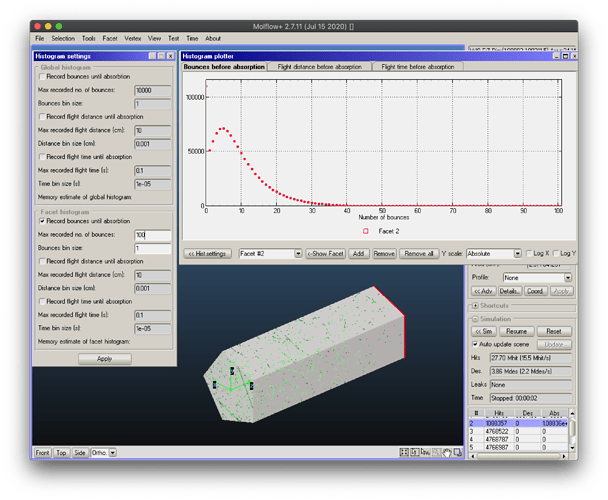Dear Marton,
It is possible to write out the position of the previous hit for all particles striking or passing through a facet? Is it possible to write out the entire history for individual particles?
Something similar has been discussed at Constant Particle Tracking, it’s not quite what I’m looking for.
The setup I am simulating has gas injected into a chamber from a small capillary. On the far side there is a small opening into a second chamber. In the second chamber, I have placed a two-sided transparent facet with an accommodation coefficient of zero where the ionization region of my mass spectrometer would be. Both chambers are pumped. I would like to figure out how many of the particles that pass through the “detector” facet flew straight from the capillary to the detector, and how many reached the detector facet after scattering in the first or second chamber.
As an aside, I know that using a single facet is not quite right: particles that pass parallel to the facet will not get recorded, even though the region in which the mass spec detects particles is three-dimensional. Would it be correct to create a cuboid with transparent, single-sided facets to register only once each particle that passes through the volume?
I have tried using the particle logger, but I would have to reconstruct the incoming path of the particle using the hit position and incoming direction information to infer from which facet it originated. Would it be possible for the particle logger to record the facet number and spatial position of the previous hit for each particle?
Inverting this, another version of the logger would be handy: one that records the positions and facet numbers of every hit for a given particle—instead of for all particles hitting a facet. The format for this file might begin with a column for the particle ID number, followed by all the columns in the present particle logger. From these data, one could make plots, after the fact, of the trajectory of a particle, rather than relying on the ephemeral “lines” tool in the GUI.
One additional suggestion for lines in the GUI that addresses a similar need: the option to limit the displayed lines to those that pass through a given facet or set of facets. In my case, I could use this for a quick, visual assessment of where particles that reach a facet originated. Assigning a different color to each particle’s line, or limiting the visible lines to the trajectory of a single particle, would also help.
In the past, I have tried to assess the fraction of “beam” or “scattered” particles reaching my detector by using temperature as a proxy for the identify of the last facet—the capillary in my setup is much hotter than the rest of the chamber—but that’s cumbersome.
Many thanks as always, and stay safe,
Alec
